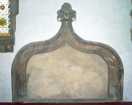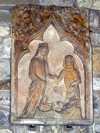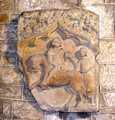For this church:    |
| |||||||
 Recess,
believed to Recess,
believed tobe the tomb of Isabel de Chauncy |
 Panel
of St Helena Panel
of St Helenafinding the True Cross |
In the south aisle of the church is a late 14th century recess under an ogee arch, with foliate decorated finial. It is reputed to be the tomb of Isabel de Chauncy, although no human remains are present.
Pevsner noted that:
the surprise of the church is two small C14 panels in the vestry, one square with St Martin and the Beggar, the other oblong with St Helena finding the True Cross. They are unrestored work of the workshops that at the same time did the Notts Easter Sepulchres (Hawton, etc) and the Southwell screen, and may have come from the priory, which was dedicated to St Helen.
At the beginning of the 15th century the church was found to be in a poor state of repair, resulting in the Pope issuing, in 1402, an indulgence for five years to such penitents who visited personally or by proxy, bringing gifts for its repair. It is known that churches appropriated by monasteries were often poorly maintained, due in part to Papal demands for money. The indulgence granted entire remission of all the penitent’s sins together with the commutation of vows of pilgrimage other than those to Rome or Compostella. The church tower was rebuilt about that time, much as it stands today with its ugly gargoyles.
After the seizure of Mattersey Priory at the dissolution of the monasteries, together with houses, church, steeple, churchyard, a warren of coneys, a water mill, a windmill, fishery rights, and the rectory and advowson of the vicarage of Mattersey, it was granted to Anthony Nevyll, Esq, of the Royal Body, and Mary his wife, together with all the priories, manors, etc, on 4th November 1539.
The structure of the priory became a quarry for building material but small sections of wall and foundations remain and these are in the care of English Heritage. The Neville family were responsible for the repair of the church chancel and it is probable that material from the priory was re-used. This may be why two carvings, attributed to the priory, were found under the chancel floor in the 19th Century although there is no indication of why or when this occurred.
It was during this time the first Parish Register was introduced. The earliest entries at Mattersey are unreadable and largely disorganised but are believed to start circa 1539 and continue until 1636 but entries up to 1620 are believed to be copies. A second register, 1653 – 1691, is described as ‘in muddled order, part Latin, and contains Commonwealth entries’. Although, where possible, the records of baptism, marriage and burial have been transcribed the originals are now difficult to read.
William Aspinal, presented to the parish in 1658 by Oliver Cromwell, was presented at Retford Quarter Sessions for not reading the Book of Common Prayer and ejected from the living of Mattersey.
A Census of 1676, for which the curate, Richard Eyre made the return, revealed that 127 people regularly attended church, there were no Roman Catholics in the parish and just five people who refused to attend church.
Churchwardens were expected to present parishioners, and others, to the ecclesiastical court for a variety of offences, including persons being absent from church for one month. Those from Mattersey presented during the reigns of Charles II and James II were George Lilleman, William Moseley, Katherine Hudson.
John Ludlam, Vicar, handwrote the oldest preserved terrier in 1743. Joshua Waddington, Vicar in 1759 and 1764, penned later notes and amendments. The latter also included a list of church Wardens – Richard Brownlow, John Thompson, Duke Hopkinson and Phillip Fellows.
Every few years the Archbishop of York undertook a visitation to the parishes in his diocese, the 1743 visitation by Archbishop Herring is one where the returns are still available and is listed separately. The Reverend John Ludlam filled in the questionnaire circulated before the visit (recorded by the Yorkshire Archaeological Society). A return from Bawtry identifies him as Master of the Hospital a position he held for many years.
In 1813 the first pre-printed register was opened. The first baptism recorded is of William Nathanial, Son of Samuel and Sarah Storrs of Sturton on the 17th January – the officiating vicar was William Hodges.
A leaden roof was installed in 1835. By 1855 the lead was bartered for a slate roof, with the consent of the vestry, by the vicar and the churchwardens.
 Panel of St Martin Panel of St Martinsharing his cloak |
White’s Directory of 1842 mentions the stone panels being discovered under the chancel floor 40 years previously. (The date of this discovery is unclear; some sources suggest 1799 others 1804). One depicts St Helena discovering the true cross, the other St Martin sharing his cloak with a beggar. They are thought to have come from Mattersey Priory.
White’s Directory of 1853 highlights the Rev W C Fenton, who founded the Yorkshire Institute at Doncaster for the deaf and dumb. By this date the institute had over 100 pupils from the counties of Yorkshire and Nottinghamshire. A note mentions the vicarage as ‘a neat house near the church’. The value of the living on the kings’ books is £6 8s 9d, from the time of Henry VIII but is now worth £260.
A note in the Parish Register states: -
On Wednesday, July 8th 1857 a new font was placed in the Parish Church, Mattersey, the expenditure of which was defrayed by subscriptions collected by the three daughters of the late W.C. Fenton, Vicar of the Parish, who died April 23rd 1855.
| The first baptism for which the new font was used was a dedication on Sunday July 19th 1857 to Hannah Ward, domestic servant to Mrs John Walker – an adult of about 20 years of age. An oak cover and a jug of brass for the water for the font was given at the same time. | |
| Vernon Musgrave, Vicar of Mattersey. | |
In 1859, Charles Musgrave, Vicar of Halifax, baptised Vernon Freshfield (born 24th October) the son of Vernon and Frances Musgrave. The younger Vernon being received into the church by his grandfather must have been a proud day for the family.
The presentation of the church passed to the Bishops of Chester in 1862.
A faculty, dated 20th March 1865, gave permission for the extensive restoration of the church.
By 1900, the value of the living had decreased to £150, derived from 130 acres of glebe land. The vicar was the Rev Samuel Kennedy.
By 1902 the churchyard was full and notification posted that it would close, except for a small number of pre-arranged interments.
The First World War did not leave the parish of Mattersey untouched. 1914 saw the Rev Mr Kennedy apply for a grant to enable Glebe land to be drained. 49 men volunteered to fight during the next few years – 19 dead are recorded on the memorial tablet.
The 1925 edition of Kelly’s Directory, mentions the installation of the tower clock in memory of those who fell in the Great War. The installation was paid for by public subscription and the clock remains the property of the parish council.
In 1943, the Rev Robert Simmons, after a long period of missionary work in Australasia and the Pacific Islands and fifteen years at Mattersey, ceded the living to take over East and West Wellow. The vicar of Holy Trinity at Everton, the Rev William Thurston, ministered to the combined parishes.
A further merger of parishes took place in 1970, with the Rev Noel Bevan adding the spiritual direction of St Peter’s at Clayworth.
An improvement in the bell loft was made 1989 when two extra bells were added to the existing three and all of them rehung on a modern frame. The cost of rehanging and one of the bells was borne by Dr Rudder.
On the 1st January 2006 the Parish of Gringley-on-the Hill was joined to the Benefice.






